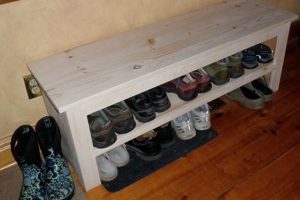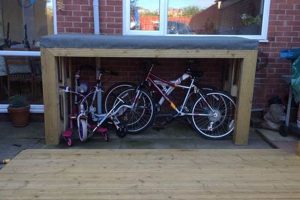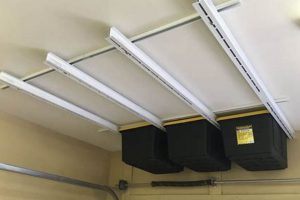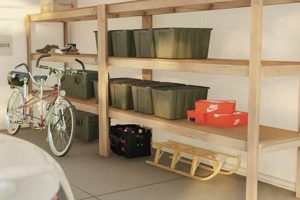Constructions blending a central living room furnishing with integral compartments offer a practical solution for spatial optimization. These units, frequently incorporating hinged tops, drawers, or shelves, provide concealed areas for items ranging from remote controls and magazines to blankets and board games. The defining characteristic is their creation and assembly by the user, often leveraging repurposed materials or standardized components available at home improvement retailers.
Such customized furniture pieces maximize utility within a confined footprint, contributing to a less cluttered and more organized environment. The creation process enables personalization reflecting specific aesthetic preferences and functional requirements not readily satisfied by commercially available alternatives. Historically, resourceful individuals have adapted commonplace items for multifaceted purposes; this approach extends that tradition to modern domestic organization.
The following sections will detail design considerations, material selection best practices, and assembly techniques applicable to developing these space-saving furniture projects. Furthermore, common pitfalls and troubleshooting methods will be addressed to ensure successful implementation.
Essential Considerations for Space-Optimized Furnishings
The following recommendations pertain to planning and executing storage-integrated furnishings, prioritizing functionality and durability for long-term utility.
Tip 1: Assess Storage Requirements. Before commencing design, meticulously catalog items intended for containment within the table. This inventory dictates compartment dimensions and overall unit scale.
Tip 2: Prioritize Material Selection. Opt for durable materials, such as hardwoods or engineered wood composites, capable of withstanding routine use and potential weight loads. Account for material stability concerning humidity fluctuations.
Tip 3: Plan for Accessibility. Design storage compartments with ease of access in mind. Hinged tops should incorporate robust hardware and safety mechanisms to prevent accidental closures. Drawers necessitate smooth-gliding hardware.
Tip 4: Emphasize Structural Integrity. Reinforce joints and connections utilizing appropriate fasteners and adhesives. Prioritize robust joinery techniques such as mortise-and-tenon or dowel construction for enhanced stability.
Tip 5: Consider Weight Distribution. Distribute weight evenly across the structure to prevent instability or localized stress. Internal dividers and bracing can aid in managing load distribution.
Tip 6: Incorporate Safety Features. Round sharp edges and corners to mitigate injury risk. Secure any potentially detachable components with appropriate locking mechanisms.
Tip 7: Finish for Protection. Apply a durable sealant or finish to protect the material from moisture, scratches, and stains. Select a finish compatible with the chosen material and intended usage.
Adhering to these recommendations fosters the creation of a robust and practical addition to the living space, maximizing storage potential while ensuring longevity.
The ensuing sections will delve into specific design blueprints and implementation methodologies applicable to a range of skill levels and project scopes.
1. Functionality
The core principle underpinning any design involving the integration of storage within a living room centerpiece revolves around the enhancement of utility within a limited area. A primary cause for undertaking such a project stems from the desire to declutter the surrounding environment. The effects are a more organized living space and potentially improved ease of access to frequently used items. In this context, functionality serves not merely as a desirable characteristic, but as a defining component. For instance, a unit constructed without due consideration for the items intended for storage, resulting in insufficient space or awkward dimensions, renders the entire endeavor functionally deficient, regardless of aesthetic appeal. Consider a scenario where a central furniture piece, while visually pleasing, fails to accommodate typical living room necessities such as remote controls, magazines, or throw blankets; its practical value is thereby diminished.
Practical applications of this understanding manifest in several design choices. Integrated compartments enable the concealment of clutter, leading to a visually neater and more organized space. Lift-top mechanisms, for instance, allow for easy access to stored items while simultaneously providing a stable surface for activities such as dining or working. Drawers incorporated into the design can offer segregated storage for smaller items, preventing disorganization. Examples of such projects may include converting an antique trunk into a central furnishing with hidden storage or retrofitting a standard table with custom-built drawers and shelves. In both cases, the success of the project hinges on the effective integration of storage capabilities tailored to specific needs.
In summary, the successful integration of storage within a living room furnishing depends directly on its capacity to fulfill specific storage needs efficiently and accessibly. Challenges in achieving optimal functionality often stem from inadequate planning, poor material selection, or flawed construction techniques. Recognizing and addressing these potential pitfalls are essential for ensuring that the finished product delivers practical benefits and enhances the overall usability of the living space, which in turn, connects directly to the overarching theme of optimized living.
2. Accessibility
Accessibility, in the context of self-constructed living room furnishings with integral storage, denotes the ease and convenience with which stored items can be retrieved or accessed. A unit that offers ample storage but requires significant effort or physical contortion to retrieve stored items negates a substantial portion of its practical value. This characteristic is not merely a convenience but a crucial functional attribute. Design choices directly influence the overall accessibility. For instance, a lift-top design allows for immediate access to items stored beneath the surface, whereas deep drawers may necessitate emptying the contents of the upper layers to reach items at the bottom. A hinged top, while offering a larger storage volume, can become unwieldy if improperly balanced, hindering smooth and safe operation.
Practical applications of accessible design include incorporating drawer slides with full extension capabilities, thereby maximizing the visible and reachable contents within the drawer. Employing lightweight materials for the construction of lift-top mechanisms can reduce the effort required to raise and lower the surface. Dividers and organizers within compartments prevent items from shifting and becoming difficult to locate or retrieve. Examples include integrating pull-out trays for electronic devices or utilizing transparent storage containers to allow visual identification of contents without requiring physical removal. The placement of the furnishing within the room also influences accessibility; a unit positioned too close to other furniture may restrict the opening of doors or drawers, diminishing its usability.
In summary, optimizing accessibility is essential for ensuring that a storage-integrated living room furnishing functions effectively as an organizational tool. Design features and construction techniques directly impact this attribute. Challenges in achieving optimal accessibility often arise from neglecting ergonomic considerations, selecting inappropriate hardware, or overlooking the spatial context of the unit within the room. Addressing these potential limitations is critical for creating a functional and user-friendly addition to the living space, thus contributing to the overall objectives of spatial optimization and clutter reduction.
3. Material Durability
Material durability serves as a foundational criterion for the long-term viability of self-assembled living room furnishings incorporating storage elements. The structural integrity and resistance to degradation of selected materials directly influence the lifespan and functional effectiveness of the resulting piece. Insufficient material strength precipitates premature failure, rendering the storage functionality ineffective.
- Wood Species Selection
The choice of wood species significantly impacts overall durability. Hardwoods like oak, maple, and cherry offer superior resistance to wear, dents, and scratches compared to softwoods such as pine or fir. Softwoods, while more economical, are prone to damage, necessitating increased maintenance and potentially shortening the lifespan of the project. Consider the expected use intensity and select accordingly.
- Engineered Wood Composition
Engineered wood products, including plywood and MDF (Medium-Density Fiberboard), present alternatives to solid wood. Plywood offers dimensional stability and resistance to warping, particularly important for large surface areas such as table tops or drawer bottoms. MDF, while smooth and paintable, is susceptible to moisture damage and may not be suitable for high-stress applications. Selecting appropriate grades of plywood and using moisture-resistant MDF in specific areas enhances overall durability.
- Hardware and Fastener Quality
The longevity of a unit is directly tied to the quality of hardware components, including hinges, drawer slides, and fasteners. Corrosion-resistant materials like stainless steel or brass are preferable for hinges and pulls, preventing rust and maintaining smooth operation. High-quality drawer slides with robust load-bearing capacity ensure smooth and reliable drawer movement over extended use. Similarly, using appropriate screws or bolts for joinery, coupled with wood glue, maximizes joint strength and prevents loosening over time.
- Surface Finish Protection
Application of a durable surface finish protects the underlying material from moisture, scratches, and stains. Polyurethane, varnish, or lacquer finishes provide a protective barrier against liquid penetration and physical damage. Regular reapplication of the finish may be necessary to maintain its protective properties and prevent degradation of the underlying material, particularly in high-use areas such as the tabletop surface.
The careful consideration of material properties and the selection of appropriate components for space-optimized furniture are paramount to ensuring long-term functionality. Compromising on material durability to reduce initial costs often results in diminished lifespan and increased maintenance requirements, ultimately negating any initial savings. Therefore, a comprehensive evaluation of intended use and environmental conditions is crucial in guiding material selection for a sustainable and practical living room furnishing.
4. Structural Integrity
Structural integrity, within the domain of do-it-yourself (DIY) coffee table storage construction, represents the capacity of the assembled unit to withstand anticipated loads and stresses without deformation, fracture, or collapse. This characteristic is not merely a desirable attribute but a fundamental requirement for ensuring user safety and prolonging the useful lifespan of the furniture piece. A deficiency in structural robustness can lead to catastrophic failure, resulting in property damage and potential physical harm. The integration of storage elements into a coffee table design inherently introduces additional weight, both from the storage mechanism itself (drawers, shelves, lift-top hardware) and from the stored contents. Thus, structural integrity becomes paramount.
The practical implications of this connection manifest in various design and construction choices. For example, a coffee table constructed from thin, unsupported panels may exhibit significant deflection under load, potentially leading to cracking or joint separation. Conversely, a design incorporating reinforced joints, thicker materials, and internal bracing distributes weight more effectively, enhancing its ability to withstand stress. The selection of appropriate joinery techniques, such as mortise-and-tenon joints or dowel construction, contributes significantly to structural soundness, particularly in high-stress areas such as leg-to-tabletop connections. Another instance is the use of high-quality fasteners (screws, bolts) and adhesives to secure joints, preventing loosening or separation over time. Examples of structural failure include sagging tabletops, collapsing legs, or drawers detaching from their slides. These failures underscore the critical role of robust construction techniques.
In summary, structural integrity is an indispensable element of DIY coffee table storage designs. It influences both the safety and longevity of the project. Overlooking this aspect can compromise functionality and increase the risk of failure. Addressing potential weaknesses through careful material selection, robust joinery methods, and adequate reinforcement ensures a durable and reliable furniture piece. The connection between structural integrity and DIY storage pieces underscores the importance of prioritizing engineering principles in furniture construction.
5. Space Efficiency
Space efficiency, when considered within the framework of do-it-yourself (DIY) coffee table storage solutions, transcends mere organizational benefit; it represents the optimization of available square footage within a living environment. The integration of storage capabilities into a central furniture piece directly addresses the challenge of limited space, particularly prevalent in urban dwellings or smaller residences. This strategic combination serves to declutter the living area while simultaneously providing accessible storage for frequently used items.
- Vertical Utilization
Vertical space utilization maximizes storage capacity within the existing footprint. Lift-top mechanisms transform the table surface into an easily accessible storage compartment, ideal for blankets, pillows, or electronic devices. Shelves positioned beneath the tabletop offer additional storage for books, magazines, or decorative items. By expanding storage upwards, the design avoids encroaching on floor space, maintaining freedom of movement within the room. An example includes adapting a standard table with a hinged top to create a hidden storage area.
- Multifunctional Design
Multifunctional designs consolidate multiple functions into a single unit. A coffee table with integrated storage can serve as both a surface for beverages and a repository for remote controls, game consoles, or board games. Drawers, compartments, and shelves provide dedicated spaces for various items, reducing the need for additional storage furniture. An example is a coffee table that functions as a work surface with built-in charging stations and storage for laptops and office supplies.
- Hidden Storage Integration
Hidden storage integration maintains a clean and uncluttered aesthetic while maximizing storage potential. Concealed compartments, such as drawers or hinged panels, blend seamlessly into the design, providing discreet storage for items that are not frequently used. This approach minimizes visual clutter and maintains a cohesive design aesthetic. An example is a coffee table designed to resemble a solid block of wood with hidden drawers accessible through push-to-open mechanisms.
- Compact Footprint Optimization
Optimizing the footprint of a coffee table ensures minimal intrusion into the living space. Designs featuring a smaller overall size or a streamlined shape maximize available floor area. Incorporating corner configurations or nesting tables further enhances space efficiency, allowing the unit to adapt to different room layouts. An example is a coffee table that expands or contracts based on space and storage needs.
In conclusion, the effectiveness of DIY coffee table storage hinges on the strategic integration of these space-efficient principles. By leveraging vertical utilization, multifunctional design, hidden storage integration, and compact footprint optimization, a customized solution maximizes storage potential within a limited area, ultimately contributing to a more organized and functional living environment.
6. Aesthetic Integration
Aesthetic integration, in the context of do-it-yourself (DIY) coffee table storage projects, refers to the seamless harmonization of the newly constructed furniture piece with the pre-existing dcor and architectural style of the living space. This process extends beyond mere visual appeal, encompassing the successful assimilation of the storage unit into the overall design scheme, preventing it from appearing as an incongruous or disjointed addition. Failure to achieve aesthetic integration can diminish the perceived value of the project, rendering the storage capabilities less desirable despite their functional benefits. The cause is often a disconnect between the materials, finishes, or design motifs employed in the DIY project and those present in the surrounding environment. The effect is a visually discordant element that detracts from the room’s overall ambiance. The significance lies in the fact that a well-integrated piece enhances the perceived value of the space, while a poorly integrated one diminishes it. For instance, a rustic-style coffee table constructed from reclaimed wood may clash with a contemporary, minimalist living room, demonstrating the importance of aligning design choices with existing aesthetic cues.
Practical applications of aesthetic integration involve careful consideration of several factors. Material selection should complement existing furniture pieces, considering wood species, colors, and textures. Finish choices should harmonize with the color palette of the room, ensuring a cohesive visual experience. Design elements, such as shapes, lines, and proportions, should reflect the architectural style of the space, whether it is traditional, modern, or eclectic. The incorporation of hardware, such as drawer pulls or hinges, should align with the existing hardware finishes and styles. For example, if the living room features brushed nickel accents, selecting brushed nickel hardware for the DIY coffee table will contribute to aesthetic cohesion. Reclaimed wood furniture pieces need careful thought to ensure that they match the existing aesthetic of the space. Similarly, the scale and proportion of the storage unit must be appropriate for the size of the room and the surrounding furniture, preventing it from overwhelming the space or appearing disproportionately small.
In summary, aesthetic integration is a crucial consideration in DIY coffee table storage projects, influencing the overall success and perceived value of the endeavor. Addressing potential challenges related to material selection, finish choices, design elements, and hardware selection is essential for creating a cohesive and harmonious living space. By prioritizing aesthetic integration, the resulting storage unit not only provides functional benefits but also enhances the overall beauty and livability of the room, underlining the value of thoughtful design planning in achieving a well-integrated space.
Frequently Asked Questions
The following questions and answers address common inquiries regarding the construction and implementation of self-assembled living room furnishings incorporating storage functionalities.
Question 1: What tools are essential for constructing units incorporating integrated compartments?
The minimum required tools include a measuring tape, saw (circular, miter, or hand saw), drill/driver with various bits, sandpaper, and clamps. Advanced projects may necessitate a router, jointer, or planer for precise shaping and finishing.
Question 2: What are the recommended joinery techniques for ensuring structural stability?
Dowel joints, mortise-and-tenon joints, and biscuit joints are generally regarded as effective for creating robust connections. The choice of technique depends on the material thickness, joint location, and skill level of the builder.
Question 3: How can the safety of hinged tops be guaranteed to prevent accidental closures?
The installation of soft-close hinges or lid support mechanisms is crucial. These devices prevent abrupt closures and reduce the risk of injury, particularly when children are present.
Question 4: What surface finishes provide optimal protection against scratches and moisture?
Polyurethane, varnish, and lacquer finishes offer durable protection against wear and moisture penetration. Multiple coats are typically required for optimal performance. Proper surface preparation is essential for adhesion and a smooth finish.
Question 5: How can drawer slides be selected to ensure smooth and reliable operation?
Full-extension ball-bearing drawer slides provide superior smoothness and load-bearing capacity compared to friction-based slides. Select slides with appropriate weight ratings for the intended contents.
Question 6: What are the key considerations for integrating electrical components, such as charging stations?
All electrical work must adhere to local building codes and safety standards. Use properly rated wiring, outlets, and surge protectors. Ensure adequate ventilation to prevent overheating.
Careful planning and execution are essential for achieving a functional and aesthetically pleasing result.
The succeeding section will delve into advanced design techniques and customization options for creating unique and personalized pieces.
Conclusion
The preceding analysis presented a comprehensive overview of constructing storage-integrated living room centerpieces. The examination spanned crucial facets including functionality, material durability, structural integrity, space efficiency, and aesthetic harmony. Adherence to these principles is paramount for realizing a successful project that enhances both organizational capacity and visual appeal within the residential environment. The exploration of space efficiency in diy coffee table storage projects underscores that this type of work requires careful deliberation.
The insights detailed herein serve as a foundation for informed decision-making, empowering individuals to undertake space-optimization endeavors with a heightened understanding of critical design and construction variables. Diligent application of these guidelines promotes the creation of enduring and practical solutions tailored to specific spatial constraints and aesthetic preferences, creating a more appealing space that is also functional.







